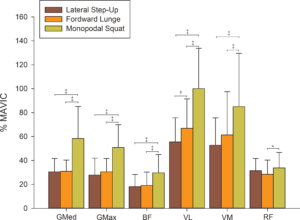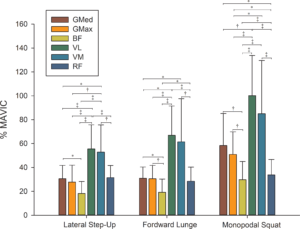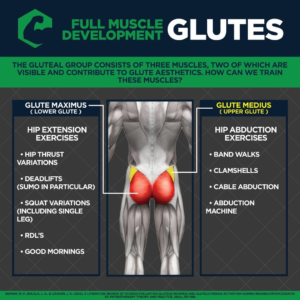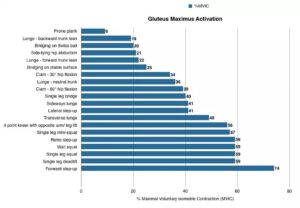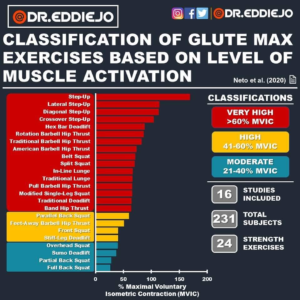SIDE or LATERAL STEP-UP RESEARCH
Click on Image to Enlarge
EMG STUDIES
GLUTEUS MAXIMUS, GLUTEUS MEDIUS & QUADRICEPS
– Side Step-up, Forward Lunge, Single-Leg Squat
Electromyographic activity during the Monopodal Squat, Forward Lunge and Lateral Step-Up exercises – 2020 – Muyor
Procedure
– physically active 10 men and 10 women) performed 5reps @60% 5RM
Results for Concentric
Gluteus Maximus: single-leg squat 50% . forward lunge 30% . lateral stepup 30%
Gluteus Medius: single-leg squat 60% . forward lunge 30% . lateral stepup 30%
Rectus Femoris: single-leg squat 35% . lateral stepup 30% . forward lunge 30%
Vastus Medialis: single-leg squat 84% . forward lunge 62% . lateral stepup 52%
Vastus Lateralis: single-leg squat 100% . forward lunge 68% . lateral stepup 52%
+ Biceps Femoris: single-leg squat 32% . lateral stepup 30% . forward lunge 28%
GLUTEUS MAXIMUS
– Side Step-up
Review of studies evaluating gluteus maximus and gluteus medius activation during rehab exercises .
Michael Reiman – 2011
Procedure
– Studies that evaluated activation of GMax during rehab exercises; Note: subjects included in this review were healthy
Results for Gluteus Maximus
– the following can affect EMG activity:
(1) trunk position
(2) movement direction
(3) base of support
– EMG ranged from 74% to 9% MVIC; strength gains are expected for activation levels = or >40% MVIC
· 74% – forward stepup
· 59% to 56% – 1-leg squat; 1-leg RDL; wall squat; retro backward stepup; 1/4 squat
· 49% to 40% – transverse lunge; sideways lunge; lateral stepup; 1-leg bridge
· 39% to 34% – clam 60º hip flexion; lunge neutral trunk; clam 30º hip flexion
· 25% to 19% – bridging on stable surface; lunge forward lean; side lying hip ab-duction; bridging on a swiss ball; lunge backward lean
·9%– prone plank
GLUTEUS MAXIMUS
– Side Step-up
Glute Max Activation during Common Strength and Hypertrophy Exercises – Review – 2020 – Neto
Procedure
– GMax activation levels during strength exercises that incorporate hip extension and use of external load
Results
– the following factors might directly influence GMax activation
(1) External load
(2) movement velocity
(3) level of fatigue
(4) mechanical complexity of the exercise
(5) need for joint stabilization
– Step-up may elicit the highest level of Gmax activation possibly due to the stabilization requirement
| Classification | Activation | Exercise | Average (%MVIC) |
|---|---|---|---|
| 1º | Very high | Step-Up | 169.22 ± 101.47 |
| 2° | Very high | Lateral Step-Up | 114.25 ± 54.74 |
| 3° | Very high | Diagonal Step-Up | 113.21 ± 43.54 |
| 4° | Very high | Crossover Step-up | 104.19 ± 33.63 |
| 5° | Very high | Hex Bar Deadlift | 88 ± 16 |
| 6° | Very high | Rotation BB Hip Thrust | 86.18 ± 34.3 |
| 7° | Very high | Traditional BB Hip Thrust | Lower GM: 69.5/Upper GM: 86.7 |
| 8° | Very high | American BBHip Thrust | Lower GM: 57.4 ± 34.8/ Upper GM: 89.9 ± 32.4 |
| 9° | Very high | Belt Squat | 71.34 ± 29.42 |
| 10° | Very high | Split Squat | 70 ± 15 |
| 11° | Very high | In-line Lunge | 67 ± 11 |
| 12° | Very high | Traditional Lunge | 66 ± 13 |
| 13° | Very high | Pull Barbell Hip Thrust | 65.87 ± 23.28 |
| 14° | Very high | Modified Single-leg Squat – Bulgarians | 65.6 ± 15.1 |
| 15° | Very high | Traditional Deadlift | 64.50 ± 41.72 |
| 16° | Very high | Band Hip Thrust | Lower GM: 49.2 ± 26.5/ Upper GM: 79.2 ± 29.9 |
| 17° | High | Parallel Back Squat | 59.76 ± 22.52 |
| 18° | High | Feet-away Barbell Hip Thrust | 51.38±17.93 |
| 19º | High | Front Squat | 40.54 ± 4.73 |
| 20° | High | Stiff-Leg Deadlift – RDL | 40.5 ± 18.8 |
| 21° | Moderate | Overhead Squat | 39.75 ± 29.91 |
| 22° | Moderate | Sumo Deadlift | 37 ± 28 |
| 23° | Moderate | Partial Back Squat | 28.16 ± 10.35 |
| 24° | Moderate | Full Back Squat | 26.56 ± 12.33 |
.

